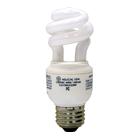Apr 28 2010
GE Lighting’s plant in Bucyrus, Ohio is fast becoming its global center of excellence (COE) for the manufacture of high-efficiency, long-life “T8” linear fluorescent light bulbs used in factories, offices, hotels, schools, government buildings and new construction to help conserve energy and reduce energy costs.
 Screw-based compact fluorescent lamp
Screw-based compact fluorescent lamp
Federal stimulus funding and incentives from the state of Ohio will help make this expansion to a COE a reality.
“Expanding our plant in Ohio to add more volume to our production allows us to maintain our current 160 jobs in today’s tough economic environment, plus we expect to add another 130 jobs over the course of the next several years,” says Peter Gabriel, GE Lighting’s manager of North America discharge plants. “This expansion, which consolidates GE Lighting’s production from Canada and Hungary into the U.S., fits nicely with GE’s American Renewal initiative and our company’s commitment to supporting job creation within the U.S. where we can be competitive on cost, quality, innovation and productivity. We have an excellent work force in Bucyrus. Add to that the government stimulus support we will receive in training grants for new employees and in income tax credits, and we have a winning combination all around.”
Vince Scarfo, GE Lighting’s government sales manager, notes, “In addition to the importance of job creation in the U.S., manufacturing T8 energy-efficient fluorescent products in Ohio means that these products will be appropriate in projects funded under the American Reinvestment and Recovery Act, which imposes a Buy American requirement for many products used in projects. This takes the hassle out of purchasing by customers subject to the provisions. But equally important, are the potential energy savings.”
As an example, Scarfo says, “A large high-rise office building that switches out 1,500, 3-lamp fixtures from standard fluorescent light bulbs to Watt-Miser® fluorescent light bulbs, utilizing the UltraMax® ballast, could avoid 24 metric tons of CO2 emissions annually on the U.S. grid, equivalent to the CO2 absorbed annually by more than six acres of Southeastern U.S. forest. The savings can be dramatic.”
In addition to the T8s, Scarfo notes that GE Lighting has many energy-efficient products that can be used in projects funded under the American Reinvestment and Recovery Act.
Scarfo says the U.S. Department of Energy has issued waivers for certain lighting products not available from U.S. manufacturers. As a result of the waiver, certain non-U.S.-made products can be used in Recovery Act-funded projects under the Department of Energy’s Energy Efficiency and Renewable Energy program. These products include:
- LED (light-emitting diodes) traffic lights, arrows and crosswalk signals;
- fluorescent electronic lighting ballasts (except for electronic dimming ballasts for fluorescent lamps that are capable of operating the lamps below 50 percent of their rate light output); and
- screw-based and pin-based compact fluorescent lamps (with the exception of plug-in CFLs longer than 10 inches).
Scarfo notes that the Buy American provisions are complex and subject to change by the government at any time. “Our GE Lighting sales team can get answers regarding any GE lighting products and solutions that comply with Recovery Act Buy American requirements.”
GE — a fluorescent leader from the start
Fluorescent lighting has come a long way over the last century. While development of fluorescent lamp technology began as early as the late 1800s, including by Thomas Edison, to whom GE traces its roots, it was in 1938 that GE proclaimed the age of fluorescence. These new, more energy-efficient fluorescent lights were seen by millions of people at the New York World’s Fair and the Golden Gate Exposition in San Francisco through 1939, which helped the new light source’s acceptance.
Today, energy-efficient fluorescent light bulbs made in the USA at the Bucyrus, Ohio, center-of-excellence plant, are sold in the U.S. and in countries around the world.